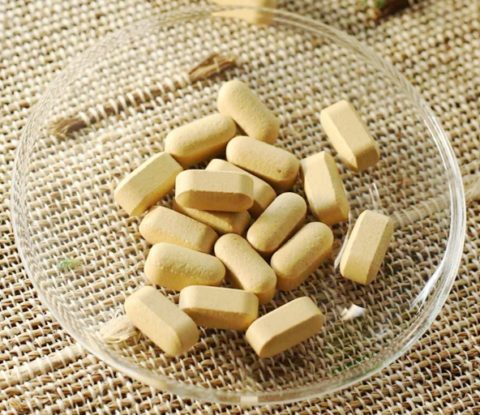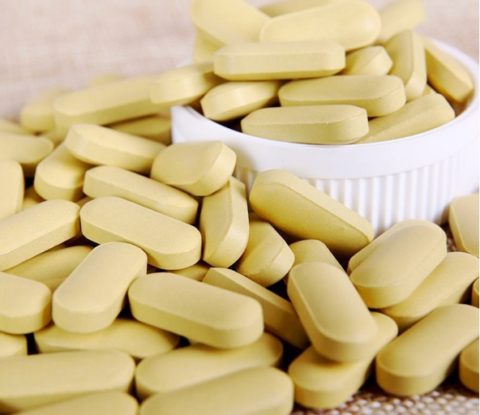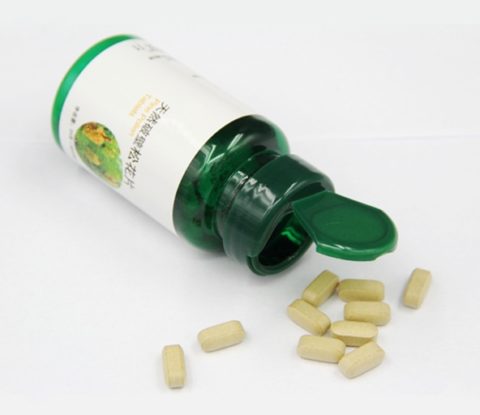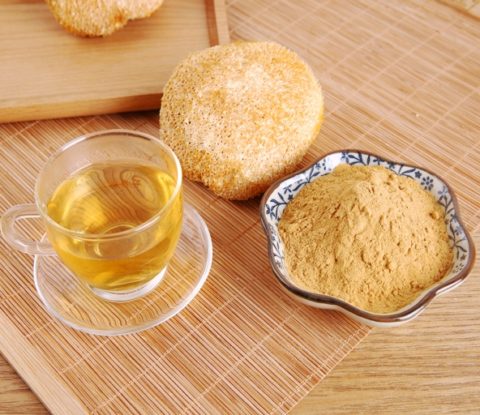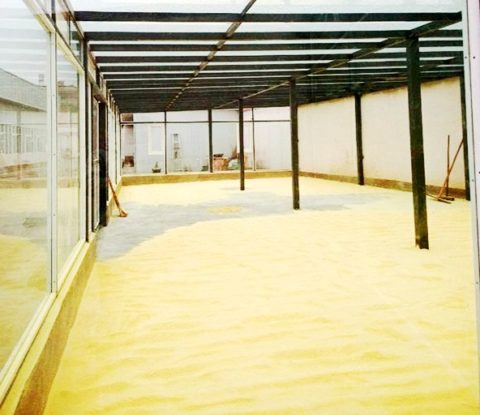
Pine Pollen and Lion’s Mane Extract Tablet
【Specification】: 0.5g/tablet
【Material Used】: Cell cracked pine pollen powder(70%)+Lion's mane extract 30% polysaccharide UV(30%)
【Dosage】: 3-4 tablets a time, twice a day based on different intention.
Pine Pollen and Lion’s Mane Extract Tablet
【Specification】: 0.5g/tablet
【Material Used】: Cell cracked pine pollen powder(70%)+Lion’s mane extract 30% polysaccharide UV(30%)
【Dosage】: 3-4 tablets a time, twice a day based on different intention
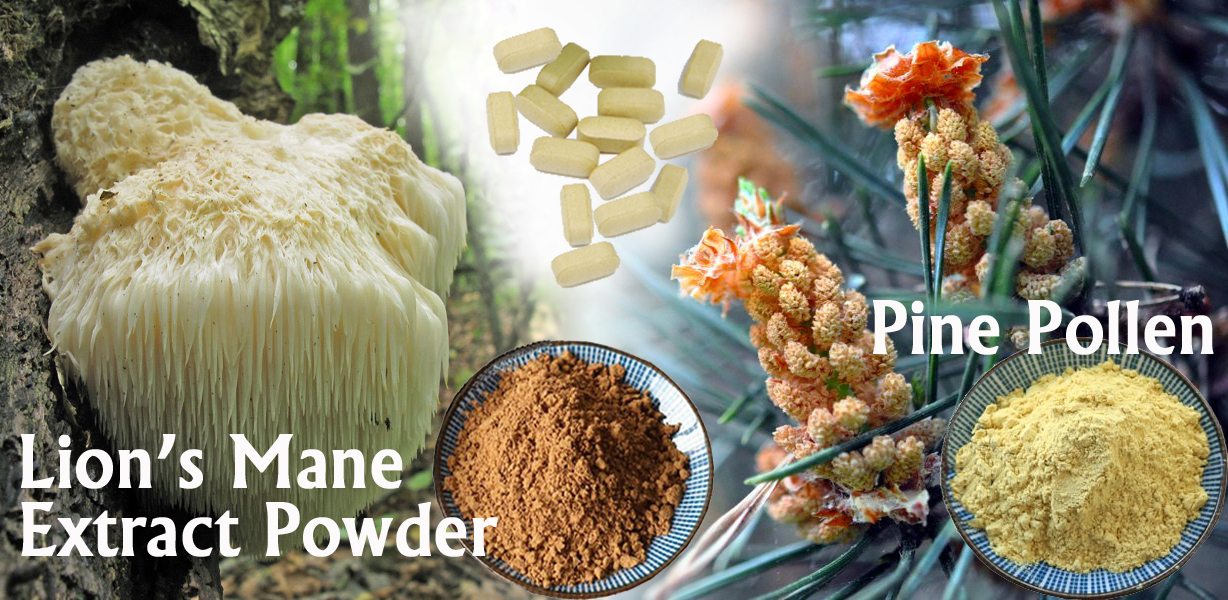 Pine Pollen and Lion’s Mane Extract Tablet Brief Introduction
Pine Pollen and Lion’s Mane Extract Tablet Brief Introduction
As we all know pine pollen powder as an adaptogen, it can helps us build resistance to daily stress and acts as a restorative for boosting immune health due to its rich nutrition like protein, vitamins, minerals, all essential amino acids, trace elements, enzymes and so on. And phytosterol that pine pollen carries could help promote and balance level of testosterone in human body. Testosterone is not only good for increasing libido but also helps to promote feelings of well being, uplifts the mood and stimulates a sense of will power and enthusiasm for life. Also phenylalanine in pine pollen, as an L-dopa precursor which helps to stimulate dopamine levels in the brain, it is additionally believed to act as a natural antidepressant. And lion’s mane mushroom is like most of mushrooms contain a group ofpolysacchaide which gives it the benefits of enhancing immunity, lowering blood sugar/pressure and anti-cancer. Especially beta-glucan in all these polysacchaide, is called “nature’s strongest immunity enhancer” in many researches, being proven could help promote immunity effectively. Meanwhile, many researches have also found lion’s mane mushroom could help to protect nerves and improve cognition. With pine pollen and lion’s mane mushroom combined, its benefits to improve immunity, release pressure, supplement testosterone and increase energy could be double reinforce, leading to a far better daily presence and sexual performance.
Since we have discussed a lot in pine pollen powder benefits(Refer to: Cell Cracked Pine Pollen Powder), we mainly focus on lion’s mane researches and benefits in below paragraphs…
Hericium erinaceus extract/ Lion’s mane mushroom extract
[Latin name]: Hericium erinaceus L.
[Other names]: Hericium erinaceus, Lion’s Mane, Monkey’s Head, Houtou (infrequent), Igelstachelbart, Pom Pom Blanc, Hedgehog Mushroom, Satyr’s Beard
[Part used]: Mycelium & Fruitingbody
[Raw material source]: Zhejiang province; cultivated with saw and wheat straw dust mixture
[Active ingredients]: Polysaccharides
Specification]: 30%
[Test method]: UV
[Extract type]:Dual Extract(grain alcohol 80% concentration, 20% water )
[Appearance]: Brownish yellow powder
[Particle size]: 95% pass 80 mesh
Hericium erinaceus (also called Lion’s Mane Mushroom) is an edible mushroom and medicinal mushroom in the tooth fungus group. Native to North America, Europe and Asia, it can be identified by its tendency to grow all the spines out from one group (rather than branches), long spines (greater than 1 cm length) and its appearance on hardwoods. Traditional medicine has always been very popular with the Chinese ever since 2000 BC. And this mushroom is quite popular among their cures. A research on this mushroom was conducted on rats in 2005. The findings unearthed several medicinal substances present in Hericium Erinaceus. The substances included Palmitic acid, Threitol and D-arabinitol. In the research, these substances were found responsible for reducing blood sugar and regulating lipid levels in blood. It was also evident that there was an antioxidant present in the mushroom.
Chemical Analysis
The mushroom Hericium erinaceus contains:
-Hericenones A and C-H
-Erinacines A-K
-Orcinol derivatives (Mycelium)
-Sialic-acid binding lectin
-Sterols, such as ergosterol and beta-sitosterol.
And a polysacchaide component (Hericium erinaceus ) – Polysaccharides, named HEF-P and belonging to the beta-glucan family; which can be broken down into four polysaccharides. The percentage of polysaccharides in the fruiting bodies seems to be around 20%, with 18.59% found with an ethanol extraction with the overall structure of these polysaccharides comprising xylose (7.8%), ribose (2.7%), glucose (68.4%), arabinose (11.3%), galactose (2.5%) and mannose (5.2%).
The total phenolic content of Hericium erinaceus appears to be in the range of 10.20+/-2.25mg gallic acid equivalents (GAE) per gram (about 1%) with the hot water extract, which appears to be up to 5-fold higher than oven cooked levels and either methanolic or freeze-dried fruit bodies. This 10.20+/-2.25mg GAE/g (phenolic content) is significantly less than the reference d-rug of Quercetin (194.24+/-7.58) and on a potency basis the overall antioxidant potential of Hericium erinaceus is about 17.7% that of quercetin in vitro. The polysaccharides themselve are also active in vivo, with 300mg/kg of the polysaccharides daily for 15 days can reduce the oxidative changes induced by ischemia/reperfusion.
Pharmacological Actions
1. Interactions with Neurolog
1).Neurogenesis
Hericium erinaceus has been noted to increase mRNA expression of nerve-growth factor (NGF) in isolated astrocytes to around 5-fold that of control at 100-150ug/mL of the ethanolic extract in a concentration dependent manner, with no efficacy noted in the water extract. When testing hericenones C-E, none were found effective in the range of 10-100ug/mL and inhibiting JNK signalling appears to prevent Hericium erinaceus from acting (with p38 MAPK, PKA, PKC, and MEK not being involved).
An increase in NGF mRNA has been detected in the hippocampus, but not cortex, of mice given 5% of the diet as Hericium erinaceus for a period of seven days to around 1.3-fold of control. Hericium erinaceus ethanolic extract appears to increase NGF mRNA levels, and this has been confirmed following oral administration to mice. Secretion of NGF from astrocytes has been noted to be increased with 150ug/mL of the ethanolic extract but not 50-100ug/mL while isolated erinacines (A-C) are known to stimulate NGF secretion at 1mM concentrations, with a potency greatly exceeding that of adrenaline at the same concentrations. Seceretion of NGF from astrocytes has been noted to be increased with incubation of Hericium erinaceus ethanolic extract. When looking at neurons specifically, Hericium erinaceus appears to promote neuronal prolongation and formation of myelin.
2.) Glutaminergic Neurotransmission
Neuronal excitability from glutamic acid appears to be attenuated in the presence of Hericium erinaceus extracts.
3). Neuroprotection
An analogue of the Hericenones, called 3-hydroxyhericenone, has been implicated in preserving neurons from death induced by endoplasmic reticulum stress. This mechanism of action is also seen with various benzene compounds in Hericium erinaceus.
It has also been shown, in vitro, to enhance myelination (production of myelin sheath) of neurons, which may be downstream of NGF.
4). Cognition
Hericium erinaceus appears to protect rats against cognitive decline caused by β-amyloid pigmentation at the same 5% of the diet seen previously. One human study using 3g of 98% Hericium erinaceus powder (in capsule form) showed significantly improvements on a rating scale of dementia in persons suffering from general cognitive decline. The supplement increased cognition relative to control, and the degree of improvement increased with time; however, 4 weeks after cessation saw the start of a decline back to normal despite still being significantly elevated above control.
Anxiety and Depressive symptoms have also been reduced in humans fed 2g of Hericium erinaceus, via cookies, over the course of 4 weeks. There was a significant difference between groups on the measurements of concentration and irritability, favoring the Hericium erinaceus group.
5). Nerve Injury
In one study conducted in rats, Hericium erinaceus water extract was able to promote neuronal regrowth after crushing injury. Rats that had a gluteal nerve damaged (purposefully) during surgery were able to walk better after ingestion of water containing the extract of the fruits. Two doses used in this study were 10 or 20mL per kg bodyweight daily, but the exact mg or mmol dose was not recorded; the two doses, however, did not differ between each other. This was conducted as a follow-up to an in vitro study suggesting neuronal growth from Hericium erinaceus, which showed no toxic symptoms.
2. Cardiovascular Health
1). Blood Pressure
Hericenone B has been shown to exert anti-platelet actions by inhibiting signalling from collagen through α2/β1 to release arachidonic acid (one of the two receptors that mediates thrombosis via collagen); the mechanism appears to be potent but specific in tested rabbits, with complete inhibition at 30μM (similar to 5μM aspirin as reference d-rug) and near complete at 10μM. Interestingly, hericenones C-E failed to have any influence on collagen-induced platelet aggregation, and while hericenone B was active on other forms of aggregation (adrenaline and U46619 but not ADP nor thrombin) it was less effective.
Hericenone B appears to potently and specifically inhibit collagen-induced platelet aggregation, with other hericenones not having much of an effect and other forms of aggregation not being significantly affected. The concentration this occurs at suggests that it is biologically relevant. Hericium erinaceus appears to be an ACE inhibitor (hot water extract of the fruiting bodies) with an IC50 value of 580+/-23µg/mL, significantly less than the most potent tested mushroom Ganoderma lucidum (50µg/mL).
Hot water extracts of mushrooms tends to be more potent ACE inhibitors than ethanolic or methanolic extracts, and mushroom bioactives that have been noted to inhibit ACE include D-mannose (IC50 of 3mg/mL) and L-pipecolic acid (IC50 of 23.7mg/mL). As these molecules themselves are weaker than Hericium erinaceus, it is currently thought that bioactives peptides underlie the ACE inhibitor potential as they have been detected in mushrooms before (Val-Ile-Glu-Lys-Tyr-Pro[ and Gly-Glu-Pro).
Hericium erinaceus has ACE inhibiting properties, although they appear to be pretty weak and may not be biologically relevant. The exact molecule underlying these effects is not currently known, but it may be a bioactive peptide.
2.) Lipids and Cholesterol
Both a hot water and ethanolic extract of Hericium erinaceus have been tested in hyperlipidemic mice at 2% of the diet (1.896-3.16g/kg hot water and 2.016-3.36g/kg ethanolic) is able to reduce triglycerides (8% hot water and 27.1% ethanolic relative to control) without any apparent effect on HDL-C nor total cholesterol. These hypolipidemic effects were also observed in liver tissue (29.8% hot water and 38.8% ethanolic) and was thought to be related to the ability of the ethanolic extract to act as a PPARα agonist with an EC50 value of 40µg/mL; there was an increase in genes downstream of PPARα but no changes in PPARα expression.
Hericium erinaceus may act as a PPARα agonist and reduce triglycerides without any apparent effect on cholesterol. Although both the hot water and ethanolic extracts have been found inactive on cholesterol and HDL-C, an extract derived from the mycelium of Hericium erinaceus (ethanolic extract which was then lyophilized) appeared to reduce LDL by 45.5% and improve HDL-C by 31.1% when taken at an oral dose of 200mg/kg with 50mg/kg also being somewhat active.
Although the fruiting body of the mushroom (edible portion) does not appear to significantly influence lipoprotein and cholesterol metabolism, the mycelium may reduce cholesterol.
3. The Stronggest Immunity Enhancer
From the chemical composition of lion’s mane mushroom, we know it is rich in beta-glucan. β-Glucans (beta-glucans) are polysaccharides of D-glucose monomers linked by β-glycosidic bonds. β-glucans are a diverse group of molecules that can vary with respect to molecular mass, solubility, viscosity, and three-dimensional configuration. They occur most commonly as cellulose in plants, the bran of cereal grains, the cell wall of baker’s yeast, certain fungi, mushrooms and bacteria. Some forms of beta glucans are useful in human nutrition as texturing agents and as soluble fiber supplements, but can be problematic in the process of brewing.
Yeast and medicinal mushroom derived β-glucans are notable for their ability to modulate the immune system. In Roger Mason’s BookWhat is Beta-glucan?,he argue beta-glucan is the stronest immunity enhancer in nature. And he mentioned below several cases conducted in different universities:
The best review of all was published in the Journal of the American Nutraceutical Association (v 3, 2001). This was done at the Universityof Louisville with a full 49 references. “Beta Glucans as Immunomodulators”. “The immunomodulating effects of beta glucans are well established during the development of immune reactions.” All the human references will be covered in this chapter.
At TulaneUniversity (Annals of Surgery v 211, 1990) trauma patients were about to undergo surgery for their injuries. Half were given beta glucan, and half were given placebos. The ones who got the glucan had a zero total mortality rate, compared to a full 29% mortality rate for the ones who got the placebo!!! A zero mortality rate! The doctors said macrophages are key to immunity, and glucans are proven macrophage stimulants. This was over 20 years ago, but beta glucan is still not given to patients prior to or after surgery. This should be routine.
Again, in the above journal (v 220, 1994) at HarvardUniversity patients undergoing serious thoracic and abdominal surgery were given either beta glucan or a placebo. Over one fourth of people undergoing major surgery get infectious complications. The average cost per patient is over $12,000. “Patients who received beta glucan had significantly fewer infectious complications, decreased intravenous antibiotic requirement, and shorter intensive care stay. Beta glucan is safe, and appears to be effective in the further reduction in the morbidity and and cost of major surgery.” Very well put.
A second study at Harvard Medical School (Archives of Surgery 129, 1994) was very similar to the above. More high-risk surgical patients were given beta glucan, while others were given placebos. The ones getting the beta glucan were given varying doses, both before and after their thoracic and abdominal surgeries. Only one of the patients got an infection who was taking high dose glucan. Four of the placebo patients got serious infections. They concluded, “Beta glucan was generally safe and well tolerated, may decrease postoperative infection rates, and warrants further investigation.”
At Tokyo University (Surgery Today v 23, 1993) people with gastric cance-r were given glucan from lentinan mushrooms. Some were given intravenous glucans, and some simply water both before and after surgery. Very sophisticated diagnostic tests were done, especially for lymphocytes.
The results are too sophisticated (i.e. measuring exotic parameters like Leu11, CD4 and LeuM3 cells) to discuss by name, but their immunity was dramatically increased. The surgeries were far more successful, with less infection and complications, in the glucan patients.
At MinooCityHospital in Japan (Japanese Journal of Cancer and Chemotherapy v 30, 1981) lentinan glucan was given to more gastric cance-r patients. This was a full 30 years ago! People with gastric cance-r have low immunity and poor quality of life when undergoing chemotherapy. Surgery is risky and complications are common. Even with the harmful medical treatments that continued their immunity was improved with a better quality of life giving them mushroom glucan.
At YamaguchiUniversity in Japan more lentinan glucan was given to people after dangerous cardiopulmonary bypass surgery (CPB). This may be the most dangerous of all surgeries. This was published in the International Journal of Immunopharmacology (v 21, 1999). Half the patients were given lentinan glucan and half were not. “The preoperativeadministration of lentinan for patients undergoing CPB ameliorated the impairment of natural killer cell activity, and promoted the rapid recovery of the CD4 positive cells. “
There are more examples cased are listed in his book to prove the immunity change the patients underwent after being given lion’s mane mushroom supplement. From these cases we could make the conclusion that lion’s mane’s mushroom could effectively promote immune condition for patients and for sub-healthy people in modern society.
4. Interaction with cancer
Hericium is highly prized for its immune stimulation properties, and its anti-cancer, anti-tumour and anti-metastasis effects. These desirable effects can be attributed to several key factors which include: The highly diverse β-glycan polysaccharidespresent in the fruit body and the mycelium. Hericium also possesses a high degree of poly-phenol and polysaccharide associated anti-oxidants, anti-inflammatory constituents and multiple unique small molecules, which in themselves have been shown to thwart rouge cancer cells.
These small molecules include the hericenones, specifically hericenone-A and hericenone-B, which are best known for their cognitive improvement effects via the stimulation of nerve growth factor (NGF) in the central nervous system. Recently,Hericenone L and an isohericenone have been discovered and shown to exhibit anti-cancer activity against esophageal and colon carcinoma cancer cell lines, respectively. Hericium mycelium extracts showed anti-proliferative activity against a variety of cell lines that included: Stomach (MKN-45); colon (HCT116), mammary (MCF-7), lung (NCIH-460), prostate (PC-3) and liver (HepG2) cells.
One of several “direct” mechanisms proposed to confer the notable anti-cancer effect mediated by these small molecules present in Hericium is the induction of programmed cell death – termed apoptosis – by a sensitization process involving intracellular signalling. This effect renders cancer cells susceptible to effective chemotherapy and directly leads to specific cancer cell destruction, while not interfering with normal cells or their function.
Diverse β-glycan polysaccharides have been extensively characterized in the Hericium fruit body and mycelium. Also important are the high level of β-glycan polysaccharides produced and excreted into the extracellular environment in which the mycelium grows – these have been termed the exopolysaccharides. The polysaccharides tend to have β-1,3 and β-1,6 molecular structures, are water or alkali soluble, and possess anti-tumor/cancer properties by modulating immune responses. Polysaccharides present in Hericium can activate macrophages (immune cells, which specifically seek out and destroy cancer cells).
Another family of key small molecules which are ubiquitous in the membranes of fungi are ergosterol and its derivatives. Ergosterol derivatives, for example ergosterol peroxide, have been shown to induce apoptosis (programmed cancer cell death) in a variety of cell types and/or the prevent cancer cell migration (metastasis;). Ergosterol is best known as the precursor to Vitamin D2. A smaller proportion of ergosterol is present in the ergosterol-peroxide form (approximately 23%). Hericium is rich in both ergosterol and ergosterol peroxide. Ergosterol peroxide is a key molecule which directly induces cancer cell apoptosis. This effect has been shown to occur in pancreatic, leukemia, and breast cancer cells.
